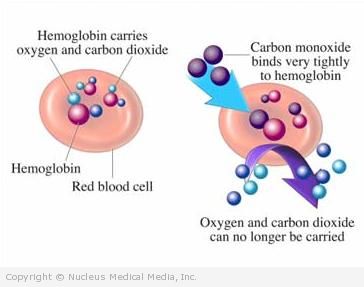Carbon Monoxide Poisoning
Carbon Monoxide Poisoning – Definition
Carbon monoxide poisoning can be a deadly condition. It results from inhaling carbon monoxide gas (CO). CO is produced when gas, wood, charcoal, or other fuel is burned. It often builds up when fuel-burning heating and cooking devices are faulty or not properly vented. A car engine can also produce CO, as can cigarette smoking. CO is odorless, tasteless, and colorless gas. People can inhale it without knowing.
Once the gas is inhaled, it is easily absorbed through the lungs. Hemoglobin carries oxygen in the blood to the entire body. CO binds tightly with hemoglobin and takes the place of the oxygen. Tissue becomes starved for life-sustaining oxygen. Brain tissue is very much at risk.
Carbon Monoxide Poisoning – Causes
Inhaling CO gas causes carbon monoxide poisoning.
People can be exposed to the gas when fuel-burning appliances are broken or are not vented properly. For instance:
- If a vent pipe has a hole, carbon monoxide can escape into the house.
- Using a barbecue grill or camp stove indoors can cause a build-up.
- Running a car engine with the garage door closed will cause a build-up.
Carbon Monoxide Poisoning – Risk Factors
A risk factor is something that increases your chance of getting a disease or condition.
Risk factors for carbon monoxide poisoning include:
- Exposure to carbon monoxide through improperly vented or faulty appliances
- Age:
- Fetuses (Maternal cigarette smoking is a major source of exposure.)
- Infants
- Older adults
- Smoking (Waterpipe tobacco smoking may put you at an even higher risk.)
- Geography: northern states
- Gender: death rates higher in males
- Blood, heart, or lung conditions
Carbon Monoxide Poisoning – Symptoms
Symptoms related to carbon monoxide poisoning are usually vague. They can be split into acute (immediate) and chronic symptoms.
Acute Symptoms
- Shortness of breath
- Wheezing
- Cough
- Hoarse voice
Chronic Symptoms
- Rapid heart rate
- Chest pain
- Nausea or vomiting
- Headache
- Numbness and tingling
- Disturbed vision
- Loss of appetite
- Disturbed sleep
- Dizziness
- Tiredness
- Memory loss
- Reduced sex drive
Carbon Monoxide Poisoning – Diagnosis
The doctor will ask about your symptoms and medical history. A physical exam will be done. You will be asked questions about:
- Whether symptoms come and go
- If anyone else in the household feels ill
- If you use fuel-burning appliances
Tests may include:
- Blood tests — to measure oxygen level and electrolytes
- Carboxyhemoglobin test — to help determine the severity of exposure and monitor treatment
- Chest x-ray — a test that uses radiation to take a picture of structures inside the chest, used to help determine if pneumonia is present
- Electrocardiogram — a test that records the heart’s activity by measuring electrical currents in the heart muscle
Carbon Monoxide Poisoning – Treatment
Move away from the source of the carbon monoxide. Breathe fresh air outdoors. Mild symptoms usually start to resolve after getting away from the gas.
Seek medical care at the closest emergency room. Explain that you think you may have been exposed to carbon monoxide. The doctor may give you oxygen until your symptoms go away and CO levels in your blood drop.
Other therapies may include:
- Ventilator — Patients in a coma or with serious heart or nerve involvement may need a ventilator to help them breathe.
- Hyperbaric oxygen therapy — Patient is placed in a special chamber in which oxygen is under greater pressure than normal.
Carbon Monoxide Poisoning – Prevention
Avoiding exposure to CO is the key to preventing carbon monoxide poisoning. Because the gas has no odor or color, you will not know if it is present. The following suggestions can reduce your risk of exposure:
- Have an expert check your fireplace chimney every year. Debris can block vents, making a build-up of carbon monoxide.
- Before the start of the heating season, have a professional check that your gas and kerosene appliances are working properly.
- Make sure all gas and combustion appliances are vented to the outdoors through pipes with no holes.
- Do not use your gas stove or oven for heating your house.
- Do not use a barbecue grill, camp stove, or unvented kerosene heater inside your house or tent.
- Do not use generators or other gasoline-powered engines indoors.
- Only buy and use equipment that carries the seal of the American Gas Association or the Underwriters’ Laboratory.
- Do not rely exclusively on a carbon monoxide detector. Use one only as backup, in addition to preventive measures. Follow manufacturer’s directions for installation and maintenance.
- Ask a mechanic to check your car’s exhaust system every year.
- Do not run the car in the garage, especially with the door closed. Start the car and take it outside.
- Do not leave the door from the garage to the house open when the car engine is running.

